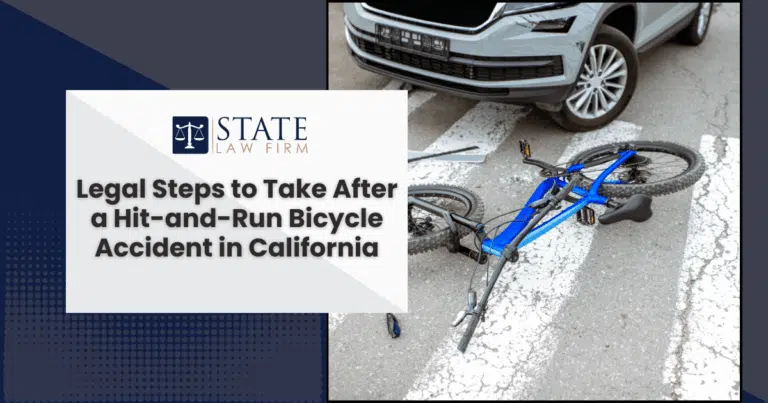In the chaos of California traffic, bicyclists often face the most significant risks, and unfortunately, not all drivers take responsibility when accidents occur. Hit-and-run bicycle collisions can leave victims with not only physical injuries but also a deep sense of injustice and confusion about what to do next. If you’ve been hit while riding and the driver fled the scene, know that you’re not alone, and legal support is available.
According to the National Highway Traffic Safety Administration, over 1 in 5 pedestrian and bicycle fatalities involved a hit-and-run driver in recent years, a troubling trend that continues to impact California’s most vulnerable road users.
At State Law Firm, we understand how overwhelming the aftermath of these incidents can be. As a boutique personal injury law firm based in Sherman Oaks and run by young attorneys passionate about litigation, we’re committed to helping victims of hit-and-run bicycle accidents seek justice and secure the compensation they deserve. Whether unsure of your next legal move or needing guidance navigating complex insurance hurdles, this guide walks you through each critical step.
And if you’re ready to speak with an attorney who will truly advocate for you, visit our Sherman Oaks car accident lawyer page to learn how we can support your legal and personal recovery.
Understanding Hit-and-Run Bicycle Accidents: The Basics
A hit-and-run bicycle accident occurs when a motorist collides with a cyclist and leaves the scene without stopping to provide identification or offer assistance. In California, fleeing the scene of an accident involving injury is a criminal offense under Vehicle Code Section 20001—but that doesn’t always stop reckless drivers from disappearing.
Bicyclists are especially vulnerable on the road. According to the California Office of Traffic Safety, over 10,000 bicyclists are injured in traffic collisions annually across the state. When the at-fault party vanishes, victims are left not only with injuries but with the burden of pursuing justice in a system that’s already complex.
California law generally imposes liability on the fleeing driver, but in their absence, insurance and legal strategy become key. That’s where experienced advocacy can make a difference.
Immediate Actions to Take After a Hit-and-Run Bicycle Accident
The moments after the crash are critical if you’re ever involved in a hit-and-run as a cyclist. Here’s what you should do:
- Get to safety: If possible, move out of traffic and assess your injuries.
- Call 911: Request both emergency medical assistance and police response.
- Gather what you can: If you can, take photos of the scene, your bike, and any visible injuries.
- Speak with witnesses: Get contact information and ask them what they saw.
- File a police report: This documentation is essential for insurance and future legal claims.
Pro Tip: Even if you feel “okay,” always get checked out by a medical professional. Adrenaline can mask serious injuries.
Documenting Your Injuries and Damages for Legal Purposes
Proper documentation can make or break your case. Begin compiling:
- Medical records and bills from ER visits, physical therapy, or ongoing treatment
- Photos of injuries at different stages of healing
- Receipts for bike repairs or replacements
- A pain journal noting how your injuries impact your daily life
Keeping these organized and dated helps paint a complete picture of the impact on your well-being—something insurance companies won’t volunteer to consider.
Gathering Evidence: Key Information You Need
Without a known driver, your evidence becomes your most potent weapon. In addition to the police report, look for:
- Eyewitness accounts with written or recorded statements
- Video footage from nearby businesses, traffic cameras, or bystanders
- Photos of the accident scene, including road conditions, skid marks, or debris
- Any vehicle descriptions or partial license plate numbers
Pro Tip: If you’re unsure where to begin, a qualified attorney can help issue preservation letters to secure surveillance footage before it’s erased.
Navigating Insurance Claims After a Hit-and-Run Incident
Many cyclists don’t realize that their auto insurance, if they have it, may provide coverage under uninsured motorist (UM) provisions. Here’s how the process works:
- Check your UM policy or household policy to see if it extends to bicycle accidents
- Submit a claim promptly with as much supporting documentation as possible.
- Communicate cautiously with adjusters—remember, they don’t work for you.
Handling a hit-and-run claim can be emotionally exhausting. When dealing with pain, paperwork, and pushback from insurers, having a team behind you that knows how to push back harder can be significant relief.
The Importance of Legal Representation After a Hit-and-Run Bicycle Accident
Bicycle accident claims—especially hit-and-run ones—are rarely straightforward. Insurance companies may delay, deny, or downplay your claim. Here’s why working with a lawyer matters:
- We investigate when others won’t—reconstructing accidents, interviewing witnesses, and reviewing footage
- We advocate for full and fair compensation, including future medical care and emotional suffering.
- We prepare litigation cases if insurance companies do not act in good faith.
At State Law Firm, we’re proud to be a team of young, driven attorneys who don’t shy away from the tough cases. We handle each client’s claim like it’s going to trial—because sometimes, that’s precisely what it takes to get results.
And if you’re ready to understand your rights and legal options after a hit-and-run, our Sherman Oaks car accident team is here to listen, guide, and advocate for you every step of the way.


